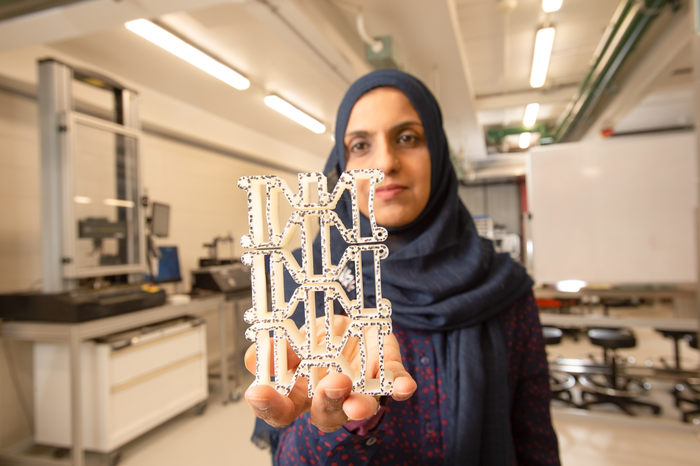The design of a 3D-printed product has gained inspiration from a material utilized in memory foam pillows and running shoes. This could help safeguard buildings from collision damage and other high-impact forces, comparable to a car traveling at 60 km/hour.
 Dr. Tatheer Zahra was inspired by a material used in running shoes and memory foam pillows to design a 3D-printed product that could help protect buildings from collision damage and other high impact forces, equivalent to a car traveling at 60 km/hour. Image Credit: Queensland University of Technology.
Dr. Tatheer Zahra was inspired by a material used in running shoes and memory foam pillows to design a 3D-printed product that could help protect buildings from collision damage and other high impact forces, equivalent to a car traveling at 60 km/hour. Image Credit: Queensland University of Technology.
Dr. Tatheer Zahra from the Queensland University of Technology (QUT) Centre for Materials Science and QUT School of Civil and Environmental Engineering utilized off-the-shelf bioplastic to 3D print geometric shapes that tend to mimic the behavior of auxetic materials.
The study has been reported in the Smart Materials and Structures Journal.
Rather than flattening when stretched or bulging when compressed, auxetic materials expand or contract in all directions at once, which makes them highly energy-absorbent and load resistant. But existing commercial auxetic material is expensive and not locally available, so I designed geometric shapes that achieved the same behavior.
Tatheer Zahra, Center for Materials Science, School of Civil and Environmental Engineering, Queensland University of Technology
Dr. Zahra stated 3D printing auxetic geometries could help replace fiber and steel reinforced polymer mesh reinforcements in composites. Also, they can be employed as flexible and extensively applicable protective wall render.
She feels that the energy absorption would be corresponding to a thick reinforced composite protective render measuring around 20 mm over a full-scale building wall. This could possibly resist the impact force of a car traveling at 60 km/hour.
At scale, composites embedded with these geometries could theoretically resist high impact or shock energy caused by gas explosions, earthquakes and wind forces, and car collisions. In Australia, there’s an estimated 2000 vehicular crashes each year. Direct building damage cost at 2.5 percent would put the damage bill at about $38.65 M/year for housing.
Tatheer Zahra, Center for Materials Science, School of Civil and Environmental Engineering, Queensland University of Technology
“Since vehicles also crash into apartments, office building, restaurants and convenience stores, this cost of building damage would probably be higher. Loss of life would be the highest cost,” added Zahra.
Dr. Zahra said safety for masonry walls was particularly significant since it was considered a vital part of the majority of the residential and commercial buildings. She added, “Masonry is a very cheap material that is resilient to noise, heat, and has better fire protection properties compared to wood or steel, but its mortar joints weaken the overall structural strength.
“If auxetic geometries were embedded into the mortar to make protective composites, they would also be protected from microorganisms and temperatures over 60 °C, and should last the design life of the structure,” noted Dr. Zahra.
Having proven at lab scale, Dr. Zahra currently seeks to test the designs on full-scale masonry and concrete structures at the QUT Banyo Pilot Plant.
The designs would be good prospects for commercialization through additive manufacturing because the production process is flexible and materials are readily available. 3D printing would also allow us to change the material, size or design of geometric shapes to suit different structures and load requirements.
Tatheer Zahra, Center for Materials Science, School of Civil and Environmental Engineering, Queensland University of Technology
According to Dr. Zahra, bioplastics offered a more endurable, low carbon emission that is alternative to other non-biodegradable polymers or fiber-reinforced plastic. Furthermore, she believes that it is more economical compared to making use of available auxetic fabrics, which could cost up to $400 per square meter and were not biodegradable.
Journal Reference:
Zahra, T (2021) Behavior of 3D Printed Re-entrant Chiral Auxetic (RCA) Geometries under In-Plane and Out-of-Plane Loadings. Smart Materials and Structures. doi.org/10.1088/1361-665X/ac2811.
Source: https://www.qut.edu.au/